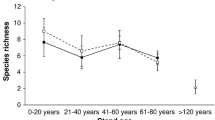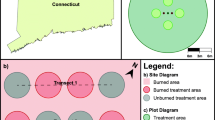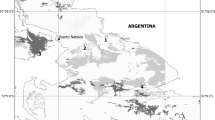Abstract
We surveyed vegetation along forest margins in a 65-year chronosequence of old-fields at the Cedar Creek Natural History Area in east-central Minnesota, USA, to identify successional patterns of woody plants and to determine if these were correlated with soil nitrogen. We predicted that shrub and tree abundance, size, and distance of occurrence from the forest edge would be correlated with field age or soil nitrogen. Instead we did not find successional trends in the abundance or composition of woody species. Even in the oldest field the abundance of trees and shrubs was low and concentrated in areas close to the forest. Though trees were larger and present further from the forest edges in older fields, average tree height was less than 126 cm in all fields.
Since we did not find successional trends we looked at various local factors (local seed sources, deer browsing, and forest edge aspect) and their relation to recruitment, mortality, or growth to explain variation among fields in abundance of trees or shrubs. The three most common tree species (Quercus rubra, Q. macrocarpa,and Populus tremuloides) all had a higher relative abundance of seedlings, and two (Q. rubra and Q. macrocarpa) had a higher relative abundance of large trees adjacent to forests with a high abundance of conspecific adults. Most trees taller than 20 cm were browsed by deer and were shorter in 1995 than they were in 1993. Mortality was higher for trees less than 30 cm indicating that mortality was size-dependent. Forest edge aspect did not significantly influence the abundance or demography of any species. Our results suggest that the patterns of seedling recruitment were largely determined by the proximity of seed sources and that these patterns may persist so that tree communities in old-fields resemble adjacent forests. Deer may be a significant factor in the suppression of tree populations in old-fields through repeated browsing which reduces tree growth and elevates tree mortality by prolonging the period of time trees remain susceptible to size-dependent mortality.
Similar content being viewed by others
Author information
Authors and Affiliations
Rights and permissions
About this article
Cite this article
Lawson, D., Inouye, R.S., Huntly, N. et al. Patterns of woody plant abundance, recruitment, mortality, and growth in a 65 year chronosequence of old-fields. Plant Ecology 145, 267–279 (1999). https://doi.org/10.1023/A:1009873127360
Issue Date:
DOI: https://doi.org/10.1023/A:1009873127360




